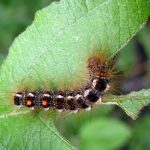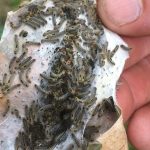Browntail moth is back! Gardeners and picnickers, alert! We’re approaching the first molt for the browntail moth caterpillars, and that means their tiny itchy spines will be blowing around on the warm air, settling on chair arms and seats, on plants in the garden and leaves that need raking.
Browntail moth caterpillars are easy to spot. They’re brownish, sparsely haired, and have white side stripes and double orange spots at the end. Wash them off buildings and cars with a hose, drown them in soapy water, burn or crush them, but don’t pick them up with care hands.
Combat browntail moth!
Combat the itchy rash reaction first by avoiding. Wipe down the arms and seats of outdoor chairs before you sit. Wear gloves and long sleeves to garden (also a bit of protection against ticks) and garden when the wind is still, like in the morning. If you have browntail in your neighborhood, don’t hang clothes, sheets or towels, or bathing suits on the line to dry! Keep your car windows closed to prevent itchy browntail moth spines from settling in your upholstery.
Change your clothes after working in a browntail area, and take a warm shower immediately. Rinse your hair! If you do end up with browntail, there are several OTC medications that might help, like for poison ivy. Calamine lotion, Sarna, benadryl. If you get blisters or raw skin, call your doc and get a prescription. Kennebec Pharmacy (in a high browntail area) has created a prescription spray. Sometimes you’ll need a prescription steroid-type cream.
What does browntail look like?
 Browntail moth loves oak, shadbush, apple, cherry, beach plum, and rugosa rose. So if you have apple or crab apple in your yard, or oak trees, check the ends of the branches for the rolled up leaves/shaggy caterpillar nests. Those are last year’s wintering over spots.
Browntail moth loves oak, shadbush, apple, cherry, beach plum, and rugosa rose. So if you have apple or crab apple in your yard, or oak trees, check the ends of the branches for the rolled up leaves/shaggy caterpillar nests. Those are last year’s wintering over spots.
According to the Maine.gov site, in late June, the larvae spin rough cocoons in which to pupate. Pupal cocoons are full of toxic hairs and should be removed from buildings or trees only with great caution. The pupae develop into moths which emerge from the cocoons in July. This is the time when the grown caterpillars are changing into moths and shedding their skins, including the itchy hairs. The moths have a wingspread of about 1 1/2 inches and are strongly attracted to light. Wings and midsection are pure white while the abdomen (rear part of the body) is brown with a conspicuous tuft of brown hairs at the tip.
 After emerging, the females lay eggs in masses on the underside of leaves and cover the eggs with brown hairs from their bodies. Each female lays 200 to 400 eggs. The eggs hatch during August or early in September and the young larvae feed for a short time on the leaves before building their winter webs. This fall feeding does little damage to the trees. Read more on the state of Maine web page on browntail moth.
After emerging, the females lay eggs in masses on the underside of leaves and cover the eggs with brown hairs from their bodies. Each female lays 200 to 400 eggs. The eggs hatch during August or early in September and the young larvae feed for a short time on the leaves before building their winter webs. This fall feeding does little damage to the trees. Read more on the state of Maine web page on browntail moth.